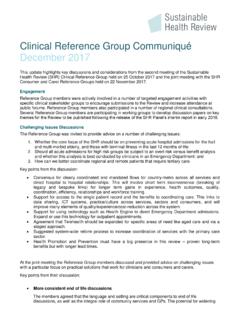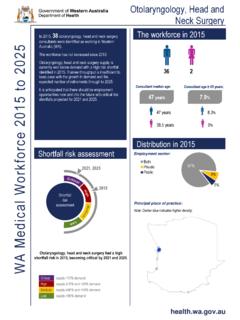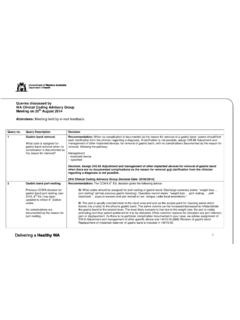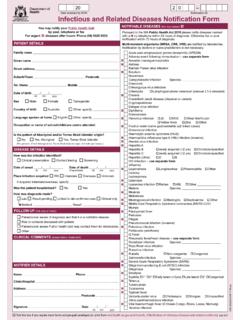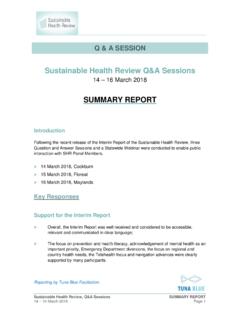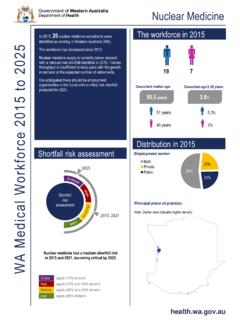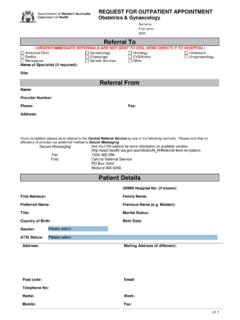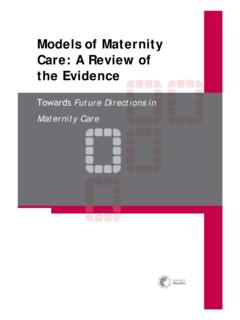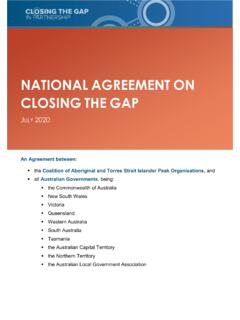Transcription of Understanding Institutionalised Racism - Department of …
1 aboriginal Health Policy Directorate, System Policy and Planning Division, Department of Health A culturally respectful and non-discriminatory health system Understanding Institutionalised Racism Suggested citation aboriginal Health Policy Directorate, 2017, Understanding Institutionalised Racism , Department of Health of Western Australia, Perth. Enquiries should be directed to: aboriginal Health Policy Directorate Public and aboriginal Health Division Department of Health Western Australia 189 Royal Street EAST PERTH WA 6004 Phone: (08) 9222 2478 Email: 1 Contents Introduction 2 Defining Racism 2 Racism and aboriginal health outcomes 3 Why recognising Racism as a key social determinant of health is important 4 How can Institutionalised Racism be addressed? 5 Building cultural competency in WA Health 5 1. Governance: 5 2. Policy implementation: 6 3. Service delivery: 6 4. Recruitment and employment: 6 5. Financial accountability: 6 References 8 2 Introduction Historically, Racism in Australia has been expressed as an overt and straightforward rejection of, and hostility towards, a minority group underpinned by beliefs of biological difference and inferiority.
2 Racism was publically displayed, socially accepted and, in many circumstances, upheld by Government policy and legally sanctioned ( the White Australia Policy and forcible removal of aboriginal children from their parents). Although there has been a significant shift away from blatant forms of Racism , accompanied by major changes in government policy and legal frameworks around racial discrimination, more subtle forms of Racism have persisted. Modern forms of Racism are more difficult to identify, complex and entrenched. Understanding the nature and existence of modern forms of Racism is essential in order to recognise and counter it successfully. Defining Racism Racism can be broadly defined as behaviours, practices, policies, beliefs and prejudices that underlie avoidable and unfair inequalities across groups in society based on race, ethnicity, culture or religion (Berman & Paradies, 2010).
3 This definition encompasses overt forms of Racism such as racial abuse and refusal of a service, as well as more subtle forms of Racism such as racial stereotyping and microaggressions. Racism can occur at different levels that are interrelated and often overlap in practice (Paradies et. al, 2008). For the purposes of Understanding the impact of racial discrimination on aboriginal health care, the focus is: Interpersonal Racism : Interactions between people that maintain and reproduce avoidable and unfair inequalities across minority groups. For example, microaggressions include commonplace daily verbal, behavioural, or environmental indignities, whether intentional or unintentional, that communicate hostile, derogatory, or negative racial slights and insults (Sue et al, 2007). Institutionalised , or systemic, Racism : The sometimes unconscious and unintentional embedding of practices, policies or processes within systems or institutions that maintain and reproduce avoidable and unfair inequalities.
4 This follows from the assumption that the dominant group represents the normative and superior culture, with minority groups representing aberrations of some form or other. Institutionalised Racism often involves assimilationist goals whereby the minority group is incorporated in to the dominant group so that their valid needs do not receive recognition (Sanson, 1997). 3 Racism and aboriginal health outcomes In response to the identification of Racism as a key driver of ill-health in the National aboriginal and Torres Strait Islander Health Plan 2013-2023 (National Health Plan), Pat Anderson - Chairwoman of the Lowitja Institute, stated: .. there is a growing body of evidence that the health system itself does not provide the same level of care to Indigenous people as to other Australians. This systemic Racism is not necessarily the result of individual ill-will by health practitioners, but a reflection of inappropriate assumptions made about the health or behaviour of people belonging to a particular group.
5 What the research tells us, then, is that Racism is not rare and it is not harmless: it is a deeply embedded pattern of events and behaviours that significantly contribute to the ill-health suffered by all aboriginal and Torres Strait Islander Australians. (Anderson, 2013). The Implementation Plan for the National aboriginal and Torres Strait Islander Health Plan 2013-2023 defines its application of the term Racism as follows: Racism is a key social determinant of health for aboriginal and Torres Strait Islander people, and can deter people from achieving their full capabilities, by debilitating confidence and self-worth which in turn leads to poorer health outcomes. Evidence suggests that Racism experienced in the delivery of health services contributes to low levels of access to health services by aboriginal and Torres Strait Islander people. ( Department of Health (Cth), 2015).
6 Racism is understood to have a negative impact on health and wellbeing outcomes for a number of reasons (Paradies et al., 2009): Racial discrimination restricts access to resources required for health ( employment, housing and education) and increases exposure to health risks ( unnecessary contact with the criminal justice system). Affected individuals can internalise negative evaluations and stereotypes of their own group, leading to poor self-esteem and stress which may have a negative impact on psychological and physiological wellbeing, including depression and anxiety. It can result in individuals disengaging from healthy activities ( exercise and taking medications), disengagement with services ( Discharge against Medical Advice) and can lead to behaviours with negative health impacts ( smoking, problematic alcohol and other drug use). The impact of Racism upon health and wellbeing outcomes for aboriginal people is supported by a growing evidence-base.
7 For example: A study conducted in a rural town of WA (Larson et al., 2007) found the 183 aboriginal respondents had lower health component scores, were more than twice as likely to report fair-to-poor general health and to 5 times more likely to report negative racially based treatment (compared to non- aboriginal respondents). aboriginal respondents who reported negative treatment were more likely to have poor health. A cross-sectional study of 345 aboriginal people aged 16 20 years concluded that self-reported Racism was associated with poor social and emotional wellbeing outcomes, including poor overall mental health and suicide risk (Priest et al., 2011). 4 Analysis of the Darwin Region Urban Indigenous Diabetes (DRUID) study indicated that Racism explained one-third of the prevalence of depression and poor self-assessed health status among Indigenous Australians, and of the 312 Indigenous participants, 70 per cent reported experiencing interpersonal Racism (Paradies & Cunningham, 2009).
8 In the case of kidney transplants, Anderson et al. (2012) found that treating specialists reliance on notions of Indigenous Australians being commonly characterised as 'non-compliers' in their decision-making for transplant referral is likely to result in continuing disadvantage for Indigenous Australian end-stage kidney disease patients. Why recognising Racism as a key social determinant of health is important Institutional, or systemic, Racism is often difficult to recognise and counter, particularly when it occurs within institutions and systems that do not perceive the impacts of their policies, practices or procedures as racially discriminatory, nor seek to address this as a contributing factor in unequitable outcomes. It is critical to the achievement of better health outcomes for aboriginal people that WA Health recognises Racism as a key social determinant of health for aboriginal people, and to strive for health care to be free from Racism .
9 The Commonwealth Government has taken the important step of recognising that Racism is a key social determinant of health for aboriginal and Torres Strait Islander people. Racism is identified as such in the National Health Plan and includes the goal that All health care, whether government, community or private, is free of Racism . The National Health Plan also acknowledges that direct discussion on Racism is not easy: Discussion about Racism is difficult and highly charged in the Australian community and action should be focused on the development of respectful relationships and sanctioning of discriminatory behaviour, policies and practices, including within the health system . The need to address Racism is further embedded in the Implementation Plan for the National aboriginal and Torres Strait Islander Health Plan 2013-2023 through the action: Systemic Racism and discrimination is better understood, addressed and prevented.
10 One of the 2018 deliverables for the above action states: Indicators for measuring cultural safety, such as discharge from hospitals without medical advice, and elimination of the differentials in access to best practice clinical care for aboriginal and Torres Strait Islander patients irrespective of geography and socioeconomic status will be considered in the preparation of the data development plan. 5 How can Institutionalised Racism be addressed? In developing a matrix for identifying, measuring and monitoring institutional Racism within Public Hospitals and Health Services in Queensland (the Matrix), Marrie and Marrie (2014) highlighted five key indicators of Institutionalised Racism : 1. Governance: aboriginal representation in governance structures, including at Executive and Board level, for direct involvement in decision-making and legal visibility in enabling health service laws and regulations. 2.

